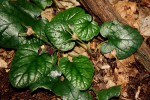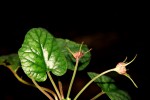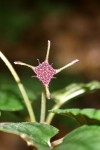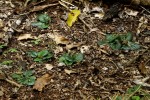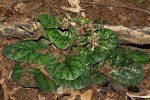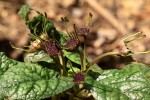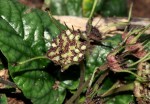| Home | > | List of families | > | Moraceae | > | Dorstenia | > | zambesiaca |
Dorstenia zambesiaca
Selected images: Click on each image to see a larger version and details of the record View all images (7)
Detailed records: Display species records QDS maps by: Google Maps Point records by Google Maps
Species details: Click on each item to see an explanation of that item (Note: opens a new window)
| Synonyms: | |
| Common names: | |
| Frequency: | Local and uncommon. |
| Status: | Native |
| Description: |
Herb with a creeping rhizome. Aerial stem up to 15 mm, with very short internodes. Leaves spirally arranged, ± in a rosette. Petiole 3-5 cm long, Lamina 2-5 × 3 - 5.5 cm, ovate to ± circular with 5-6 pairs of lateral veins; apex rounded and base cordate. Inflorescences solitary, 3-5 mm in diameter, borne on a peduncle. Receptacle broadly funnel-shaped, circular to stellate in outline. Appendages borne in 1 row; primary 3-5, spathulate; secondary linear to subspathulate, much shorter than the primary. Male flowers crowded: perianth lobes 3; stamens 3. Female flowers: perianth conical; stigmas 2. |
| Notes: | Hijman, in Kew Bulletin, Vol. 45, No. 2 (1990), p. 367, states that this species "... has a habit exceptional in Africa, but similar to that found in several Neotropical species". |
| Derivation of specific name: | zambesiaca: of the Zambezi region |
| Habitat: | In leaf litter of forest, growing in shade. |
| Altitude range: | |
| Flowering time: | |
| Worldwide distribution: | Confined to central Mozambique in the general area of Inhamitanga, Caia and Chupanga (Lacerdonia). |
| Mozambique distribution: | MS |
| Growth form(s): | |
| Endemic status: | Endemic |
| Red data list status: | Vulnerable |
| Insects associated with this species: | |
| Spot characters: | Display spot characters for this species |
| Content last updated: | Monday 7 May 2018 |
| Literature: |
Berg, C.C. (1991). Moraceae Flora Zambesiaca 9(6) Page 34. Burrows, J.E. & Burrows, S.M. (2003). Figs of Southern and South-Central Africa Umdaus Press, South Africa Pages 317 - 318. (Includes a picture). Darbyshire, I., Timberlake, J., Osborne, J., Rokni, S., Matimele, H., Langa. C., Datizua, C., de Sousa, C., Alves, T., Massingue, A., Hadj-Hammou, J., Dhanda, S., Shah, T., Wursten, B. (2019). The endemic plants of Mozambique: diversity and conservation status Phytotaxa 136 Page 91. Hijman, M.E.E. (1991). Dorstenia L. Flora Zambesiaca 9(6) Page 34. |
Other sources of information about Dorstenia zambesiaca:
External websites:
African Plants: A Photo Guide (Senckenberg): Dorstenia zambesiacaAfrican Plant Database: Dorstenia zambesiaca
BHL (Biodiversity Heritage Library): Dorstenia zambesiaca
EOL (Encyclopedia of Life): Dorstenia zambesiaca
GBIF (Global Biodiversity Information Facility): Dorstenia zambesiaca
Google: Web - Images - Scholar
iNaturalist: Dorstenia zambesiaca
IPNI (International Plant Names Index): Dorstenia zambesiaca
JSTOR Plant Science: Dorstenia zambesiaca
Mansfeld World Database of Agricultural and Horticultural Crops: Dorstenia zambesiaca
Plants of the World Online: Dorstenia zambesiaca
Tropicos: Dorstenia zambesiaca
Wikipedia: Dorstenia zambesiaca
| Home | > | List of families | > | Moraceae | > | Dorstenia | > | zambesiaca |
